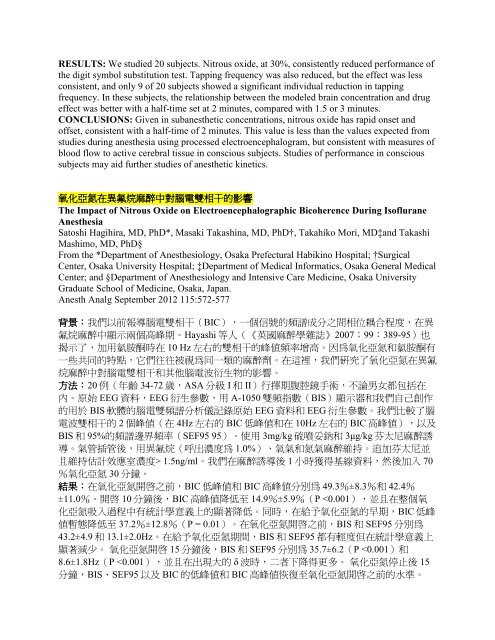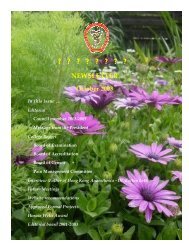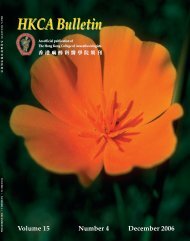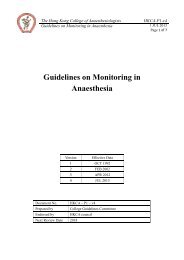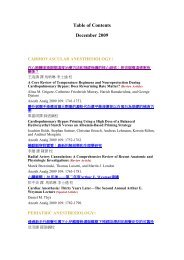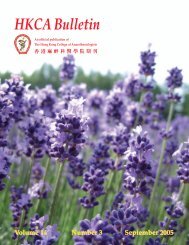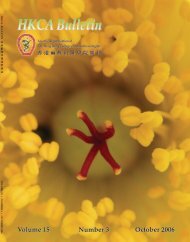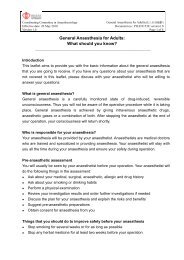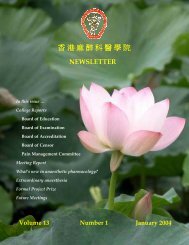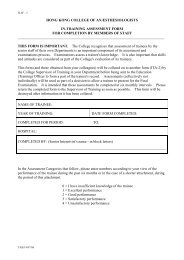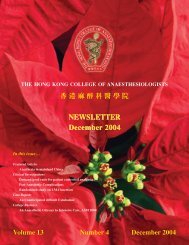Table of Contents — September 2012, 115 (3)
Table of Contents — September 2012, 115 (3)
Table of Contents — September 2012, 115 (3)
Create successful ePaper yourself
Turn your PDF publications into a flip-book with our unique Google optimized e-Paper software.
RESULTS: We studied 20 subjects. Nitrous oxide, at 30%, consistently reduced performance <strong>of</strong><br />
the digit symbol substitution test. Tapping frequency was also reduced, but the effect was less<br />
consistent, and only 9 <strong>of</strong> 20 subjects showed a significant individual reduction in tapping<br />
frequency. In these subjects, the relationship between the modeled brain concentration and drug<br />
effect was better with a half-time set at 2 minutes, compared with 1.5 or 3 minutes.<br />
CONCLUSIONS: Given in subanesthetic concentrations, nitrous oxide has rapid onset and<br />
<strong>of</strong>fset, consistent with a half-time <strong>of</strong> 2 minutes. This value is less than the values expected from<br />
studies during anesthesia using processed electroencephalogram, but consistent with measures <strong>of</strong><br />
blood flow to active cerebral tissue in conscious subjects. Studies <strong>of</strong> performance in conscious<br />
subjects may aid further studies <strong>of</strong> anesthetic kinetics.<br />
氧 化 亞 氮 在 異 氟 烷 麻 醉 中 對 腦 電 雙 相 干 的 影 響<br />
The Impact <strong>of</strong> Nitrous Oxide on Electroencephalographic Bicoherence During Is<strong>of</strong>lurane<br />
Anesthesia<br />
Satoshi Hagihira, MD, PhD*, Masaki Takashina, MD, PhD†, Takahiko Mori, MD‡and Takashi<br />
Mashimo, MD, PhD§<br />
From the *Department <strong>of</strong> Anesthesiology, Osaka Prefectural Habikino Hospital; †Surgical<br />
Center, Osaka University Hospital; ‡Department <strong>of</strong> Medical Informatics, Osaka General Medical<br />
Center; and §Department <strong>of</strong> Anesthesiology and Intensive Care Medicine, Osaka University<br />
Graduate School <strong>of</strong> Medicine, Osaka, Japan.<br />
Anesth Analg <strong>September</strong> <strong>2012</strong> <strong>115</strong>:572-577<br />
背 景 : 我 們 以 前 報 導 腦 電 雙 相 干 (BIC), 一 個 信 號 的 頻 譜 成 分 之 間 相 位 耦 合 程 度 , 在 異<br />
氟 烷 麻 醉 中 顯 示 兩 個 高 峰 期 。Hayashi 等 人 (《 英 國 麻 醉 學 雜 誌 》2007;99:389-95) 也<br />
揭 示 了 , 加 用 氯 胺 酮 時 在 10 Hz 左 右 的 雙 相 干 的 峰 值 頻 率 增 高 。 因 為 氧 化 亞 氮 和 氯 胺 酮 有<br />
一 些 共 同 的 特 點 , 它 們 往 往 被 視 為 同 一 類 的 麻 醉 劑 。 在 這 裡 , 我 們 研 究 了 氧 化 亞 氮 在 異 氟<br />
烷 麻 醉 中 對 腦 電 雙 相 干 和 其 他 腦 電 波 衍 生 物 的 影 響 。<br />
方 法 :20 例 ( 年 齡 34-72 歲 ,ASA 分 級 I 和 II) 行 擇 期 腹 腔 鏡 手 術 , 不 論 男 女 都 包 括 在<br />
內 。 原 始 EEG 資 料 ,EEG 衍 生 參 數 , 用 A-1050 雙 頻 指 數 (BIS) 顯 示 器 和 我 們 自 己 創 作<br />
的 用 於 BIS 軟 體 的 腦 電 雙 頻 譜 分 析 儀 記 錄 原 始 EEG 資 料 和 EEG 衍 生 參 數 。 我 們 比 較 了 腦<br />
電 波 雙 相 干 的 2 個 峰 值 ( 在 4Hz 左 右 的 BIC 低 峰 值 和 在 10Hz 左 右 的 BIC 高 峰 值 ), 以 及<br />
BIS 和 95% 的 頻 譜 邊 界 頻 率 (SEF95 95)。 使 用 3mg/kg 硫 噴 妥 鈉 和 3μg/kg 芬 太 尼 麻 醉 誘<br />
導 。 氣 管 插 管 後 , 用 異 氟 烷 ( 呼 出 濃 度 為 1.0%)、 氧 氣 和 氮 氣 麻 醉 維 持 。 追 加 芬 太 尼 並<br />
且 維 持 估 計 效 應 室 濃 度 > 1.5ng/ml。 我 們 在 麻 醉 誘 導 後 1 小 時 獲 得 基 線 資 料 , 然 後 加 入 70<br />
% 氧 化 亞 氮 30 分 鐘 。<br />
結 果 : 在 氧 化 亞 氮 開 啟 之 前 ,BIC 低 峰 值 和 BIC 高 峰 值 分 別 為 49.3%±8.3% 和 42.4%<br />
±11.0%。 開 啟 10 分 鐘 後 ,BIC 高 峰 值 降 低 至 14.9%±5.9%(P


